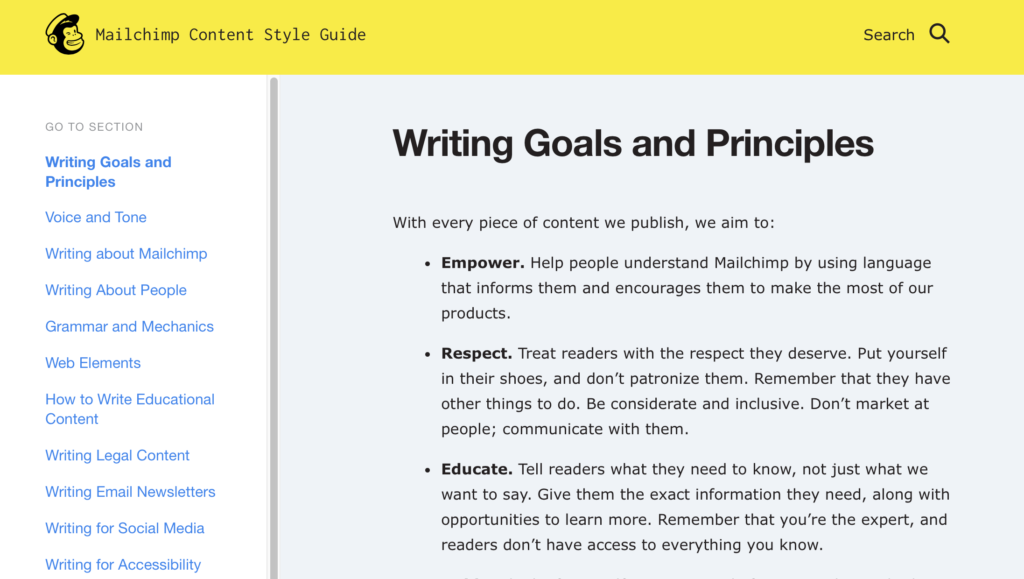Are you ready to manifest your brand in your content and ensure consistency across all communication channels? These comprehensive instructions on designing a style guide will equip you with the knowledge and tools you need to create an effective, tailor-made resource for your team. Here you will find insights and actionable tips for creating a document that unifies your messaging while embracing the distinct qualities of your brand.
What is a style guide?
A style guide is an essential tool that gives instructions on how to standardize writing styles, voice, tone, and formatting across all of your organization’s content. It serves as a reference manual containing rules and recommendations tailored specifically to uphold the values, essence, and image of your brand. A style guide also gives clear instructions on preferred language structures, grammar guidelines, or even commonly troublesome words.
Regardless of whether your content is blog posts, social media posts, whitepapers, or newsletters, the ultimate goal here is to ensure everyone adheres consistently to the same criteria; thus avoiding miscommunication, driving consistency, and enhancing trust in your brand.
Do you need a style guide?
An absolute YES! A carefully crafted style guide is the backbone of any successful content creation process, allowing you to maintain consistency, improve readability, and assert your brand’s identity consistently across various channels.
There are several reasons why incorporating a style guide into your workflow is crucial:
- Maintaining consistency: Whether you have one writer or many, ensuring that everyone adheres to the same guidelines aids in crafting consistent messaging.
- Efficient collaboration: A comprehensive style guide streamlines the editing process by providing writers with clear instructions on grammar, formatting, and company-specific language usage.
- Reinforcing brand identity: Your style guide serves as a means to showcase your brand’s voice and tone, ultimately helping in establishing your unique presence in the market.
- Simplifying onboarding: New team members can easily adapt to your company’s writing standards by referring to the style guide for content specifications, minimizing confusion and misunderstandings.
By creating a cohesive style guide, companies see enhanced efficiency in their creative processes as well as improved overall perception by audiences.
Components of a style guide
Company and product details
A comprehensive style guide should include essential information about your company, its mission, vision, and values. This may feature your logo, color palette, typography recommendations, and any relevant slogans or taglines used to define your brand identity. Additionally, providing details about product names, trademarks or service marks can help ensure proper usage throughout content creation.
Voice and tone
When creating a style guide, defining the voice and tone of your organization is crucial. Your style guide should include guidelines on maintaining a consistent voice that reflects your brand’s personality. Specify whether you want the tone to be formal or informal, professional or conversational. Other tone characteristics include human, warm, confident, professional, confident, and so on. Include examples showcasing your desired tone in various contexts to provide content creators with clear direction.
Audience information (buyer personas)
Understanding who you are addressing through your content is key information to provide in a style guide. This is a summary of your buyer persona. Give audience demographics (age range, gender distribution) as well as their beliefs, values, and buying preferences. Including this information will assist authors in crafting content tailored specifically for the target audience.
Grammar guidelines, rules, and formatting information
Your editorial style guides must establish your specific grammar preferences. Also, be sure to document your preferred headings styles, paragraph lengths, sentence lengths, bullet points usage, colons/semi-colons, capitalization conventions, and so on to maintain uniformity throughout written materials.
External references
Reference external sources such as established language guides (e.g., AP Stylebook), along with industry-specific terminology resources that authors should follow consistently. This lends credibility to the published material as it conforms with widely-accepted standards within certain sectors.
Troublesome words or specific industry jargon
Collate an alphabetical list of words commonly misused or confused within your company or industry. Offer brief explanations on the appropriate application of each term, ensuring content creators use them correctly in various contexts. Include guidance on how and when to use acronyms.
SEO and hashtag guidelines
Include guidelines on keyword optimization to boost search engine rankings and improve content visibility online. What are the top keywords in the industry? (The top ones to use in a specific piece should be provided in a content brief). Provide advice on suitable hashtag usage for increasing reach across social media platforms.
Best-performing content examples
Illustrate examples of existing content that represents your organization’s ideal writing style and tone while adhering to all other components listed throughout this style guide. This will provide authors with concrete models upon which they can base their own work.
Examples to show what’s correct v incorrect
By offering samples demonstrating both poorly-written material alongside improved versions that align with your desired approach, team members are equipped with additional guidance when presenting restyled documents for organizational distribution.
Resources to learn more about your company or industry
Lastly, it’s helpful to provide resources such as internal training modules, blogs, or websites.
Two awesome style guide examples to inspire you
Studying real-life examples of successful style guides can give you a better understanding of what to include in your own.
3. Mailchimp
Mailchimp’s Content Style Guide does a great job covering voice and tone specifics while providing resources for content creators like writers and designers alike. As a digital marketing platform, this style guide includes sections on inclusive language usage, social media conventions, and email marketing tips, among others.

4. Atlassian
Atlassian calls their style guide a design system, and indeed it tackles that scope. It starts with the brand and goes into mission, personality, promise, and vales. Their content page shows all you need to know about inclusive language, language and grammar, vocabulary, and voice and tone principles. It’s as thorough as I’ve seen.
You can leverage from these style guides, but of course you’ll want to adapt them to create a style guide tailored specifically to your company or project’s unique needs.

Best practices for creating a style guide
When creating a style guide, it’s essential to follow certain steps and best practices to present the most accurate and useful information for your team. Let’s look at three best practices.
Establish an owner
The first step in developing a style guide is appointing someone to spearhead the project. This person is ideally a senior writer who has great writing skills as well as strong organizational abilities relating to content creation. Not only do they need to understand what goes into crafting high-quality articles or documents, but they also need to be able to keep track of guidelines and ensure consistent implementation across all departments.
Here are some recommended qualities when selecting the right person:
- Familiarity with company values
- Experience in content creation and editing
- Ability to create a clear strategy
- Strong communication skills
Assigning an experienced professional who meets these criteria will set your style guide project up for success from the very beginning.
Using examples for clarity
Examples serve as valuable tools when explaining complex concepts or rules within your style guide. Including both positive (correct usage) examples along with negative (incorrect usage) scenarios can significantly improve understanding and compliance by providing clearer instructions on what is expected from writers.
Invest time in curating relevant samples—this proactive approach helps readers visualize proper implementation while preventing confusion down the line.
Making the style guide searchable
A key element of an effective style guide is its accessibility. To increase usability, make sure it features search capabilities that allow users to quickly find what they need. A searchable index or table of contents will expedite this process while improving overall efficiency within your organization.
To achieve this functionality:
- Organize headings and subheadings in a logical hierarchy.
- Leverage PDF search technology for content enclosed in text editors.
- Implement keyword tagging throughout sections for improved digital navigation.
When team members can efficiently access essential resources within your carefully constructed style guide, they’re more likely to engage with the proposed standards.
Rolling out your style guide
After designing a style guide that suits your company’s needs and preferences, it’s essential to make sure that everyone on your team understands and uses the guidelines you’ve established. Don’t expect compliance to be automatic. Successfully implementing your content style guide will improve the overall consistency and quality of your brand messaging.
Communicating the purpose of the style guide
Begin by explaining to your team members why the style guide is important. Help them understand how following a unified set of rules can increase brand recognition and effectively engage target audiences. Educate them on the specific elements in your editorial style guide and how these components relate to the broader business goals.
Communicate the benefits
To encourage widespread adoption, articulate the value of adhering to a consistent style guide across all content types. Highlight key benefits such as improving brand recognition, streamlining workflows during edits and revisions, and enhancing overall communication quality among teammates.
Schedule training sessions
Hosting training sessions or workshops for your employees goes a long way in acquainting them with the new guidelines. These sessions could include presentations about:
- Voice and tone requirements
- Essential grammar guidelines, word usage rules, and formatting information
- Terminology preferences
- SEO, and hashtag practices
Use this opportunity not only to teach but also to address any questions or concerns. Take suggestions if offered – writers often can see gaps or offer clarifications. Encourage open dialogue so everyone involved feels comfortable adopting these new standards.
Make it accessible
While creating a style guide, make sure a digital version is easily accessible to all team members who may need it. Store it on a central platform such as Google Drive, SharePoint, or an internal company wiki page so they can always reference it when needed. Also, consider creating summarized versions like cheat sheets or quick-reference guides for busy teammates who need instant support.
Establish review processes
Develop processes for experienced editors to review work produced by other writers—this aids in ensuring adherence to style guidelines while maintaining high-quality content output. Create editorial checklists for reviewers to use so they can quickly verify if writers have followed major rules from the style guide.
Treat it like a living document
It’s important to recognize that language evolves over time and that your editorial style guides must adapt accordingly. Schedule regular updates to incorporate, for example, new industry-specific words or to address gaps that writers have brought to your attention. Also, make sure your team stays informed about any changes you’ve made to keep everyone aligned.
Implementing a style guide requires effective communication and training, easy accessibility for users, well-established review processes, and adaptability over time. With these steps in place, you’ll ensure that your organization maintains a consistent and high-quality brand voice across all content channels while boosting overall user experience.
Monitor adherence
Monitoring adherence not only involves evaluating content upon submission but also conducting periodic checks on previously published material to maintain consistency. Encourage open communication between writers and editors; this allows questions about stylistic issues which could arise during production.
Recognize efforts
Consider recognizing those who adhere to the style guide consistently – perhaps through regular feedback emails, quarterly performance reviews, or other forms of acknowledgment—showcasing your appreciation for their effort toward maintaining consistency within company communications generally fosters higher levels of compliance with the guidelines stipulated within authored documents like that found within one’s editorial style guides.
Making the commitment to use a content style guide not only creates consistent and recognizable content but also fosters coherence and cohesion within your organization’s communications—ultimately bolstering your brand identity in the long run. By ensuring ease of access, offering training, clearly communicating benefits, routinely monitoring adherence, and recognizing outstanding performance—you can successfully encourage team members to adopt your style guide into their work routines and drive the presentation of your brand as trustworthy, reliable, and authoritative as a result.
Next steps
Tackling this isn’t easy. If you need help with style guide creation or training, please connect with me.





